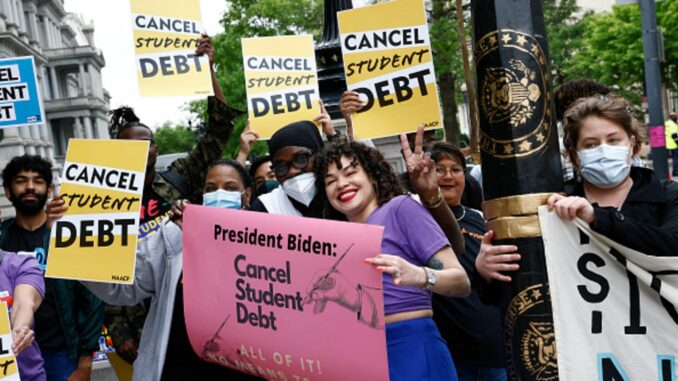As COVID emergency ends, workers hit with bigger student loan debt
In March 2020, the federal government froze payments on all federal student loans. In August 2022, the Biden Administration forgave a portion of federal student debt. Borrowers who qualified each got $10,000 of their debt forgiven, while Federal Pell Grant Program recipients got $20,000 of their debt written off. Although limited only to government-issued loans, Biden’s debt forgiveness plan gave a measure of relief to the 43 million students and graduates who qualified for debt forgiveness.

White House protest, May 12, 2020. PHOTO: Paul Morigi | Getty Images
But the ruling class is preparing to dismantle even these concessions. In November, 2022 a federal judge in Texas blocked the Biden administration’s debt forgiveness plan. The Supreme Court is currently hearing the case, and a ruling is expected in June. Payments on federal student loans will resume on June 30, but could resume earlier, depending on when the top court hands down its ruling.
Because the administration tied student loan relief to the PHE, most legal experts predict that reactionary justices will use its end in May as justification for overturning the debt cancellation plan altogether.
The denial of any debt relief and the resumption of payments in June could mean ruin for tens of millions of workers in debt who are already experiencing unprecedented financial strain and health risk from the ongoing global pandemic, which continues to disable and kill thousands of people every week. (worldometer.info)
The most impacted
The capitalist state’s catastrophic response to the pandemic and the financial burdens it has imposed have disproportionately affected Native American nations, communities of color, and working class families, including elderly and disabled people. Students and college graduates are no exception. As a recent survey has shown, Indigenous, Black, Latiné, and low-income households all carry excessive student debt. (tinyurl.com/a983y6sd)
As Cody Hounanian, Executive Director of the Student Debt Crisis Center, explained in a recent article in The Hill, “The next generation of student loan borrowers are facing a financial cliff like never before. Not only have they graduated into an unprecedented economy marred by the pandemic, inflation, and uncertainty, they are also entering the student loan system when there are many policy changes and unanswered questions about the future of federal programs.” (tinyurl.com/mux5ejdt)
Weighed down with debt, millions of young workers struggle to pay for even basic necessities. Many report working multiple jobs as they try to save whatever money they can to start paying back their loans.
As Dorian Rogers, who graduated during the pandemic, said in the same article:, “It’s hard to balance the finances between paying off your loan and living life, given our economy and what’s going on in the world.”
The termination of student loan relief will only worsen the student debt crisis, which has been raging for nearly four decades. Under the U.S.’s neoliberal austerity regime, public and privately-held student debt has nearly tripled in just 15 years. Total national student debt now stands at $1.75 trillion. Tuition costs at both state and private universities have also skyrocketed, soaring 169% from their 1980 levels.
Because bankruptcy law does not cover student debt, debtors have no legal means of escape from its crushing financial burden. For those with private student loans, even death will not erase their debt, which will pass down to surviving family members.
This explosion in debt is the result of the failing capitalist system, which has increasingly resorted to predatory lending and other forms of usury to squeeze even more value out of workers. Although the federal government currently holds most of the student debt in the U.S., it too remains bound to the profit-maximizing imperatives of finance capital. The federal government makes tens of billions of dollars every year by charging students higher interest rates than it charges banks to bail them out.
Together, all workers must mobilize for expanded student debt relief and fight for a future where college education and all forms of learning are no longer tied to profit but free to all as a human right.

